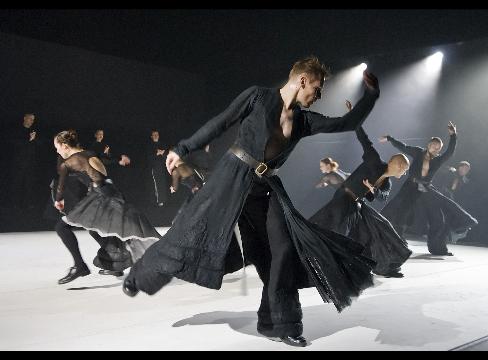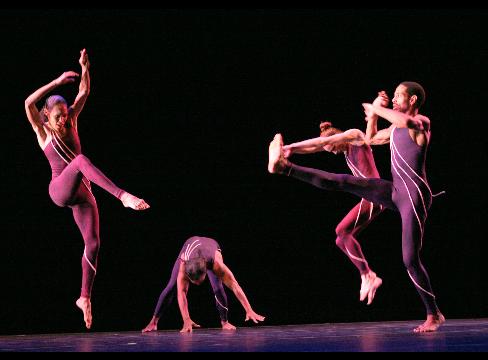This article originally appeared in the Culture section of Bloomberg News on November 9, 2007.
Nov. 9 (Bloomberg) — Swathed in black, not an inch of flesh visible but for their faces, hands and an opening at the spine or chest, eight dancers cover the stage with a heavy, awkward gait. Outstretched arms angled, torsos canted forward, they strike the floor with their sturdy shoes, their long inky skirts flapping like the wings of wounded birds.

Tero Saarinen dances with member of his company while performing “Borrowed Light” at the Brooklyn Academy of Music Opera House in the Brooklyn borough of New York, on Nov. 7, 2007. Photographer: Jack Vartoogian/FrontRowPhotos via Bloomberg News
The Finnish choreographer Tero Saarinen’s “Borrowed Light,” which opened Wednesday at the gala celebrating the Brooklyn Academy of Music’s 25th Next Wave Festival, portrays the Shakers, a Protestant sect that arose in the 18th century, seeking spiritual perfection. Believers lived communally, with Spartan simplicity, observing a strict separation of the sexes. Their rituals included a cappella singing of hymns composed by the worshippers and ecstatic dance with trembling and wrenching movements intended to cast out sin — and perhaps the tension of thwarted sexuality.
Eight black-clad singers of the Boston Camerata — an early-music ensemble led by Joel Cohen, who co-opted the Shaker music — move fluidly among Saarinen’s dancers, their voices intensifying the otherworldly element of the piece.
In particular, a solo danced by Carl Knif epitomizes the struggle between the sacred and the profane. Begun in silence, its motifs are outflung limbs, trembling fingers and a torso curving violently forward and back, making the whole body rock and stumble. The choreography, for small single-sex clusters and, of course, the full-cast passages, emphasizes the communal support these isolated people must have given one another despite their inner conflicts and dark nights of the soul.
Perfect Design
Design is a prominent partner in the effect of “Borrowed Light,” and it is perfect. Erika Turunen created the handsome costumes; Mikki Kunttu has the performers moving in a rectangle of glowing illumination in an otherwise dark space bordered by stepped platforms.
The title of the dance comes from the Shaker architectural practice of putting windows in interior rooms, so that daylight could be shared, making the workday longer. “Put your hands to work, and your heart to God” was a Shaker motto. One result of that devoted labor was the austere, graceful furniture that has outlasted the influence of the sect itself.
The dance is striking and intelligently crafted, but its conclusion — a melodramatic collision of the sexes succeeded by a consoling wallow in pathos — makes it unworthy of being compared to its great precedents — Doris Humphrey’s “The Shakers” and Martha Graham’s “Primitive Mysteries,” both created in 1931 and still the last word on plainspoken religious fervor.
Through Nov. 10 at 30 Lafayette Ave., Brooklyn. Information: +1-718-636-4100; http://www.bam.org.
Garth Fagan
“Edge/Joy,” an ingenious new work by Garth Fagan featured in his company’s weeklong run at the Joyce Theater, has a bubbling, playful air and a serious subject: how we see.
The human eye naturally gravitates to the center of the area it’s observing, the place where the important stuff is supposedly happening. Fagan challenges that habit by putting the action at the edges of the stage.
Solo, in pairs or trios, the sassily clad dancers animate borders and corners, leaving the spectators’ usual point of focus a mysterious void. Every entrance and exit is a small surprise, and each dancer seems intent on his or her own agenda. From time to time, the stage fills with the piece’s full dozen dazzling performers, passing each other as if at rush hour or with small units doing disparate things, a la Merce Cunningham.
Look Aside
“Edge” is a dance that refuses to tell you where to look, yet the jigsaw-puzzle choreography magically coheres. The music, by Ricardo Zohn-Muldoon — for inventively combined piano, strings, woodwinds and percussion — cooperates in every way.
The Jamaican-born Fagan’s signature style mixes the elegant lines, razor-sharp execution and phenomenal balances of ballet, the percussive isolations of jazz and the earthiness of modern dance with Afro-Caribbean polyrhythms.

Nicolette Depass, Steve Humphrey, Micha Scott, and Norwood Pennewell perform in the Garth Fagan Dance, “Senku” in Oct. 17, 2006. Photographer: Steven Schreiber/Ellen Jacobs Associates via Bloomberg News
Fusion is a commonplace these days, but Fagan’s style is uniquely his. Too easily, the style itself can become the whole show, though in “Edge/Joy” it’s merely the native language of a choreographer out to tell you that byways can be more rewarding than the highway.
Through Nov. 11 at 175 Eighth Ave. Information: +1-212-242-0800; http://www.joyce.org.
© 2007 Bloomberg L.P. All rights reserved. Reprinted with permission.



